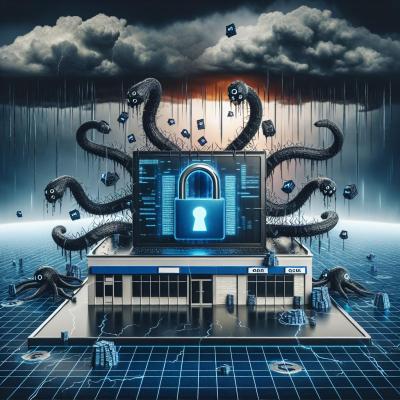Introduction: The Invisible Threat
For businesses, falling victim to a cyber attack is no longer a matter of "if" but "when." The complexity and frequency of these incidents are escalating, with adversaries relentlessly seeking out vulnerabilities. These invisible threats pose severe risks to operations, data integrity, and financial stability, making cyber security a top priority.
Take, for instance, a local retailer who, despite thriving in their niche market for years, experienced a substantial data breach. A single compromised email led to the theft of sensitive customer information, resulting in significant financial losses and, more importantly, a tarnished reputation. This anecdote is a stark reminder of how a seemingly innocuous oversight can escalate into a catastrophic event, capable of crippling an unprepared business.
Understanding the Cyber Threat Landscape
The digital domain is fraught with an assortment of cyber threats that businesses must navigate. Predominantly, Australian firms grapple with dangers such as phishing—an attempt to steal sensitive information by masquerading as trustworthy entities. Ransomware is another prevalent threat, locking businesses out of their systems until a demanded ransom is paid. And, of course, there's hacking, which involves unauthorized access to data, potentially leading to theft or corruption.
Staggering statistics highlight the growing cyber threat within Australia. According to recent reports, the economic impact of cybercrime in the country is estimated in the billions, with attacks occurring every few minutes. The financial repercussions are vast and can range from immediate monetary losses to longer-term consequences affecting customer trust and market position.
When it comes to vulnerability, certain industries stand out as prime targets for cybercriminals. Financial services, healthcare, and education sectors are among the most susceptible, given the wealth of sensitive data they handle. However, the reality is that no industry is immune. As technology integrates deeper into business processes, the potential attack surface expands, making every sector a potential victim to these silent, yet destructive, adversaries.
The Real Cost of Cyber Incidents for Businesses
Direct Financial Losses Associated with Data Breaches
Data breaches can spell immediate and severe financial harm for businesses. The costs of these incidents are multifaceted, including the expense of forensic investigation to determine the breach's origin, PR campaigns to manage the fallout, and measures to bolster security post-incident. Additionally, businesses may need to provide credit monitoring services for affected customers, further compounding direct expenditures.
Besides these immediate costs, there can be significant operational disruptions. A cyberattack might force a business to halt operations entirely, leading to lost revenue that can be devastating, particularly for smaller enterprises. The cumulative effect of these costs can escalate rapidly, with some businesses finding it impossible to bounce back, ultimately resulting in closure.
Reputational Damage and Loss of Customer Trust
Perhaps more damaging than the immediate financial impact is the long-term reputational harm a cyber incident can inflict. News of a security breach can spread swiftly, and customers may lose confidence in a business's ability to protect their sensitive information. Restoring public trust can be a lengthy and challenging process that may require substantial investment in customer relations and marketing efforts.
The loss of trust can lead to a direct loss of customers, as individuals may be reluctant to continue doing business with a company perceived as negligent with data security. The erosion of customer loyalty can be particularly devastating and can have a sustained negative impact on sales and profitability.
Legal Implications and Compliance Penalties
Following a cyber breach, businesses may find themselves mired in legal woes. They could face lawsuits from affected parties seeking compensation for damages. Moreover, there is an increasing body of regulation governing data protection, such as the Notifiable Data Breaches (NDB) scheme under the Australian Privacy Act. Non-compliance with these regulations can lead to hefty fines and penalties, compounding the financial strain on a business.
Furthermore, the resources allocated to addressing legal challenges and regulatory compliance can be substantial, diverting attention from core business activities and impeding growth. In summary, the real cost of cyber incidents extends far beyond immediate financial losses, encompassing long-term reputational damage, customer trust erosion, and a laudation of legal and compliance issues.
Case Studies: Australian Businesses Impacted by Cyber Attacks
Consider the story of a small Melbourne-based retailer that fell prey to a sophisticated phishing scheme. Cybercriminals sent an email impersonating a known supplier, requesting urgent payment to a new account. The retailer complied, only to realize the account was fraudulent. This incident not only resulted in substantial financial loss but also disrupted the supply chain, highlighting the precarious position in which a single cyber event can place a small business.
The retailer faced dire consequences, including the inability to fulfill orders, a damaged reputation due to service interruptions, and a wavering trust amongst its clientele. Following the incident, the business recognized the critical need for employee education on cyber threats and implemented stricter financial controls, emphasizing the importance of verifying any changes to payment details directly with the supplier.
Lessons Learned from a Major Corporation's Encounter with Hackers
A prominent Australian corporation experienced a defining challenge when hackers infiltrated their systems through a vulnerability in their software. The attackers gained access to confidential data, but the corporation's rapid response team managed to contain the breach quickly. As a result, the corporation invested heavily in advanced cyber defenses and thorough training for staff to identify and prevent future breaches.
The lessons from this incident stress the necessity for ongoing vigilance and investment in cyber security. Proactive measures, like regularly updating systems and conducting security audits, became central to their strategy. The corporation's proactive approach serves as a blueprint for other businesses serious about reinforcing their cyber defenses.
The Ripple Effect: How Cyber Threats Extend Beyond the Immediate Victim
The consequence of cyber threats ripples outwards, often affecting more than just the initial target. When a cyber attack impacts one company, there can be far-reaching repercussions on partners, suppliers, and customers. For instance, a breach in a service provider's system could compromise the data of multiple client businesses, amplifying the attack's scope and potential damage.
This interconnectivity exemplifies the shared responsibility in the ecosystem to maintain robust security practices. Collaboration and open communication about threats between businesses can fortify an entire supply chain against potential cyber threats. Understanding that cyber security is not a solitary pursuit but rather a collective endeavor is vital in safeguarding the broader business community.
Assessing Your Business's Vulnerability
How to conduct a cyber risk assessment for your business
Conducting a cyber risk assessment is an essential step in safeguarding your business against digital threats. Start by identifying and cataloging all assets that could be at risk – from customer data to intellectual property. After pinpointing these assets, assess the potential cyber threats each could face, considering the likelihood and impact of each scenario. By understanding your vulnerabilities, you can prioritize which areas to address first.
Next, evaluate your current security measures and identify any gaps in protection. This includes reviewing access controls, encryption practices, and incident response plans. Engaging with cyber security professionals can provide an objective analysis and guidance on the most effective strategies to mitigate identified risks. This process should be carried out regularly, as new threats can emerge swiftly and unexpectedly.
Common security weaknesses and how to address them
Businesses frequently encounter common security weaknesses such as weak passwords, outdated software, and inadequate network security. Implementing strong password policies and utilizing multi-factor authentication can significantly enhance account security. Similarly, keeping software and systems updated with the latest security patches is critical in preventing exploits.
Network vulnerabilities can often be addressed by employing firewalls, intrusion detection systems, and regularly monitoring for suspicious activity. Additionally, limiting user access to only necessary data and systems can minimize the potential damage of a security breach. Investing in robust anti-malware solutions and establishing clear cybersecurity protocols will also bolster your business's defenses against common threats.
The importance of employee awareness and training
Many cyber incidents can be traced back to human error, making employee awareness and training a cornerstone of a comprehensive cyber defense strategy. Regular training sessions can educate employees on recognizing phishing attempts, safely handling data, and responding to suspected breaches. It's crucial to foster a culture of security awareness where employees feel responsible and equipped to act as the first line of defense against cyber threats.
Simulated cyber-attack exercises, such as mock phishing emails, can be an effective way to test and reinforce this training, ensuring staff remain alert to the subtleties of cyber threats. By investing in continuous education and fostering a vigilant workforce, businesses can significantly lower the risk of succumbing to a cyber-attack due to human error.
Best Practices for Cyber Threat Prevention
Establishing Strong Cyber Hygiene Protocols
To effectively mitigate the risks of cyber attacks, businesses must adopt strong cyber hygiene protocols. This means implementing a set of practices and policies that promote the regular upkeep, safety, and monitoring of data, devices, and networks. Routine actions like changing passwords regularly, controlling user access, and managing data backups are components of a diligent cyber hygiene strategy.
Cyber hygiene also involves educating employees about the importance of proper digital habits both in and out of the workplace. Establishing a clear security policy that includes guidelines on how to securely handle sensitive information, recognize potential cyber threats, and report incidents plays a crucial role in preventing breaches and maintaining a firm's cyber-health.
Investing in Robust Cybersecurity Technologies and Services
Investing in advanced cybersecurity technologies and services is essential for defending against sophisticated cyber attacks. This includes tools like next-generation firewalls, antivirus software, intrusion prevention systems, and secure cloud services. These technologies can provide an additional layer of security to detect, block, and alert businesses to malicious activities in real-time.
Moreover, hiring a managed security service provider can offer expertise and resources that many businesses may not internally possess. These cybersecurity professionals can oversee the firm's digital defense systems, perform regular security audits, and respond to incidents with detailed recovery plans, ensuring the business is well-equipped to handle cyber threats.
Regularly Updating and Patching Systems to Prevent Vulnerabilities
Regular maintenance of IT systems is a critical but sometimes overlooked aspect of cybersecurity. Cybercriminals often exploit known vulnerabilities in software and hardware that have not been updated with the latest patches. Therefore, ensuring that all systems are regularly updated is an effective measure to close security loopholes and prevent attacks.
Automated patch management systems can streamline the updating process and ensure that critical patches are applied as soon as they become available. Additionally, conducting regular vulnerability scans can help identify weaknesses before they can be exploited. Through persistent monitoring and updating of systems, businesses can fortify their defense against the most current cyber threats and reduce the risk of a breach.
Cyber Insurance: A Safety Net for Your Business
What is cyber insurance, and why is it essential?
In a landscape where cyber threats are both unpredictable and potentially devastating, cyber insurance emerges as a critical safety net for businesses. Cyber insurance is designed to mitigate the risks associated with operating in the digital world by providing financial coverage against a wide array of cyber incidents. These policies can help cover costs that arise from breaches such as data restoration, crisis management, legal fees, and regulatory fines.
The essence of cyber insurance lies in its capacity to offer peace of mind and stability in the aftermath of a cyber attack. While companies may implement robust security measures, no system is entirely impenetrable. Cyber insurance plays an essential role in a comprehensive risk management strategy, ensuring that businesses can survive financially and continue operations even after a severe cyber event.
Key coverages to look for in a cyber insurance policy
When scouting for a cyber insurance policy, businesses should look for key coverages that align with their particular risks and needs. Coverage for expenses related to breach notifications, credit monitoring for affected customers, and data recovery services are typically included in a robust policy. Additionally, businesses should seek protection against business interruption losses, cyber extortion demands (like ransomware), and indemnification from third-party lawsuits alleging privacy violations.
Another crucial aspect to consider is the inclusion of coverage for forensic investigations to uncover the cause and extent of the breach. Professional support in managing public relations to navigate the negative impact on the company's reputation after an incident is also an invaluable coverage. Essentially, the policy should be tailored to the specific risk profile and operational context of the business.
How cyber insurance complements a comprehensive cyber defense strategy
Cyber insurance is not a stand-alone solution but rather a key element of a holistic cyber defense strategy. It complements technical and organizational safeguards by providing an added layer of protection. The right policy can bridge the gap between the costs a company incurs from a cyber attack and the investments made in preventative measures, thereby mitigating the total impact on a business's financial health.
It's important to note that while cyber insurance can help recover from losses, it cannot replace the need for rigorous cybersecurity practices. A multi-faceted approach that combines state-of-the-art security measures, ongoing employee training, and comprehensive insurance coverage is the most effective way to protect a business against the evolving threat of cybercrime.
Implementing an Incident Response Plan
Steps to create an effective incident response plan
Creating an effective incident response plan is crucial for ensuring a swift and organized reaction to a cyber incident. The initial step is to establish a framework that outlines specific procedures to follow when an incident occurs. This plan should begin with the identification of key assets and the designation of a response team with clear roles and responsibilities. From there, it should detail strategies for containment, eradication, and recovery, guiding how to limit damage, remove the threat, and restore normal operations.
Another vital component is setting up communication channels and protocols for informing all relevant parties, including employees, management, and external partners. The plan should also outline how to preserve evidence for forensic analysis and comply with legal obligations. Periodic drills and simulations will help test and refine the response plan, ensuring it remains effective against evolving cyber threats.
Roles and responsibilities within your organization during a breach
Delineating roles and responsibilities is a fundamental aspect of an incident response plan. Each member of the response team must understand their specific duties and be prepared to take decisive action. This team typically includes roles such as an Incident Manager to coordinate the response, IT professionals to tackle technical aspects, and communication officers to manage information dissemination. Depending on the organization's size and nature, legal counsel and human resources may also play a role in addressing the breach's implications.
It is imperative that all team members have access to relevant resources and authority to make critical decisions during a crisis. Moreover, clear lines of internal and external communication must be established, ensuring that there are no delays or misunderstandings when an incident strikes. Everyone in the organization, from top management to entry-level employees, should be aware of whom to contact and how to report an incident promptly.
Communicating with stakeholders after a cyber incident
Effective communication with stakeholders in the aftermath of a cyber incident is essential to manage the situation and maintain trust. A well-prepared response includes timely and transparent communication with all affected parties, including customers, employees, investors, suppliers, and regulatory bodies. It is important to convey the nature of the breach, the potential impact on stakeholders, and the actions being undertaken to resolve the issue and prevent future incidents.
While it is important to provide as much information as possible, communications should also be mindful of not compromising any ongoing investigations or revealing sensitive information that could exacerbate the situation. Adequate training and prepared message templates can help those responsible for communication provide consistent and factual updates during a high-pressure situation, aiding in the maintenance of the organization's reputation and facilitating a quicker return to normal operations.
Staying Informed: Resources and Updates
Government and Industry Resources for Cybersecurity Awareness
For businesses looking to navigate the complexities of cybersecurity, keeping informed is key. A wealth of government and industry resources are available for Australian businesses to stay aware of current cyber threats and best practices. The Australian Cyber Security Centre (ACSC) provides comprehensive guidance, risk management strategies, and real-time alerts about the latest cybersecurity incidents and vulnerabilities. Industry-specific organizations also offer resources tailored to the unique risks faced by different sectors.
Additionally, subscribing to newsletters and bulletins from reputable cybersecurity agencies ensures that companies receive timely updates on trends and advisories. These resources play a crucial role in a company's ability to preemptively address threats and bolster their cyber defense before incidents occur.
How to Stay Updated on the Latest Cyber Threat Intelligence
Staying updated on the latest cyber threat intelligence is a dynamic process that requires commitment to continual learning and adaptation. Subscribing to trusted cybersecurity feeds that offer information on the latest threats, techniques, and vulnerabilities can give businesses an edge. Leveraging threat intelligence platforms can provide tailored insights into potential risks relevant to their particular business environment and industry.
Cybersecurity forums and webinars are also practical ways to gain knowledge from experts in the field. These platforms not only provide information on emerging threats but also share case studies and best practices, offering a well-rounded view of how to implement effective cybersecurity strategies.
Networking with the Cybersecurity Community in Australia
Active networking within the Australian cybersecurity community presents an opportunity for businesses to deepen their understanding of cyber threats. This can be achieved through participation in industry conferences, workshops, and seminars. Peer-to-peer networking events provide a forum to exchange ideas and tactics with fellow professionals facing similar challenges.
Joining cyber security alliances or partnerships can facilitate collaboration and collective response strategies, significantly improving the community's overall resilience to cyber threats. By establishing connections within the cybersecurity community, businesses benefit from shared experiences, fostering a culture of proactive security and defense.
Conclusion: Building Resilience Against Cyber Threats
The landscape of cyber threats is perpetually evolving, presenting ongoing challenges to businesses of all sizes. Acknowledging these threats and adopting a proactive stance is essential for ensuring long-term protection. By recognizing that cybersecurity is not a finite goal but a continuous process, organizations can build resilience against the unpredictable nature of cyber attacks.
Investing in rigorous cybersecurity measures, staying informed on the latest threats, and cultivating an organizational culture that prioritizes cyber hygiene, are pivotal factors. This proactive approach reduces the chances of incidents and minimizes the impact of any attacks that do occur.
Proactive cybersecurity measures involve a strategic blend of technology, training, and best practices. Regular risk assessments, updating and patching systems, and employee cybersecurity training programs form the bedrock of a robust cyber defense strategy. Furthermore, developing and rehearsing an incident response plan ensures preparedness and a coordinated response in the face of a breach.
The role of cyber insurance in fortifying businesses against attacks
In conjunction with these preventive measures, cyber insurance provides an additional layer of security. It acts as a financial cushion and a recovery tool, offering resources and support when breaches occur. Policies tailored to the specific risks faced by an organization can play a critical role in recovering from cyber events and preserving business continuity.
Final thoughts on maintaining vigilance in the evolving cyber landscape
To thrive amidst the ever-changing cyber threat landscape, businesses must remain vigilant and adaptive. The concept of cyber resilience must be ingrained in the corporate ethos, supported by ongoing efforts to enhance cybersecurity postures. Collaborating with the broader cybersecurity community and leveraging shared knowledge are strategic moves toward a more secure future. This combined effort allows businesses to anticipate threats, respond effectively to incidents, and maintain trust among stakeholders.
Ultimately, the responsibility of cybersecurity rests with everyone within the organization. By prioritizing and investing in cybersecurity now, businesses lay the foundation for enduring innovation, growth, and safeguarding against the cyber threats of tomorrow.
Published: Wednesday 17th January, 2024
Last updated: Wednesday 17th January, 2024









